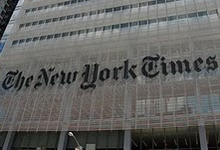The New York Times Co.’s clutch of 16 midsized and small newspapers was a relic of the prosperous pre-digital days of the 1980s and 1990s. Back then, the very comfortable margins at these properties (mostly in the Sun Belt) provided reliable cash flow if the more competitive national and New York markets hit a bump.
Now the regional group is not as profitable, and its ad revenue continues to decline substantially as The New York Times’ stabilizes. Those papers probably have become more a management distraction than a cash cushion for the company. So the pending sale of the group to Halifax Media Group, while unexpected, is easy to explain.
The Times Co. can use the proceeds for the next wave of digital development at The New York Times. The company has hinted in presentations to investors and analysts that it hopes to acquire some digital start-ups as well.
The timing also matches a thaw in the climate for such transactions in recent months. During the worst of the downturn when advertising was in free-fall, hardly any newspaper organizations changed hands, except for cases in which private equity firms bought companies — such as the Star Tribune and Philadelphia Newspapers — out of bankruptcy. Attractive properties like the Austin American-Statesman and Landmark’s papers in Norfolk, Roanoke and Greensboro were pulled back from auction after they garnered tepid bids.
This fall, Warren Buffett’s Berkshire Hathaway bought his hometown Omaha World-Herald for $200 million (including assumption of $50 million in debt). A local hotel magnate bought The San Diego Union-Tribune for more than $100 million from hedge fund Platinum Equity. Groups of smaller papers have also started to change hands.
The transaction price for the Times’ newspaper group hasn’t been specified, but I would be surprised if it takes a big tax hit as a result. In better times, huge capital gains exposure was another reason for companies to hold on to what they acquired.
Halifax, the buyer, has only been in business two and a half years, acquiring The Daytona Beach News-Journal for a rock-bottom $20 million out of receivership after a long legal battle between a family ownership group and minority investor Cox. But Halifax does have a potent financial backer in the huge Stephens Group investment firm of Little Rock, Ark. (which also owns the Las Vegas Review-Journal).
As the Daytona transaction was closing in March 2009, the newspaper cut 48 positions from a staff of 470, including most top executives. A year later, the paper raised eyebrows with an offer to pay reporters and editors a commission on any subscriptions or advertising they sold.
So my forecast would be for the usual newsroom cost-cutting, outsourcing and centralized production. The editorial ambition that won the regional group’s flagship, the Sarasota Herald-Tribune, its first Pulitzer this April for an investigation of the insurance industry may not fit with the boosterish, pro-business agenda Halifax defined in Daytona Beach.








Comments